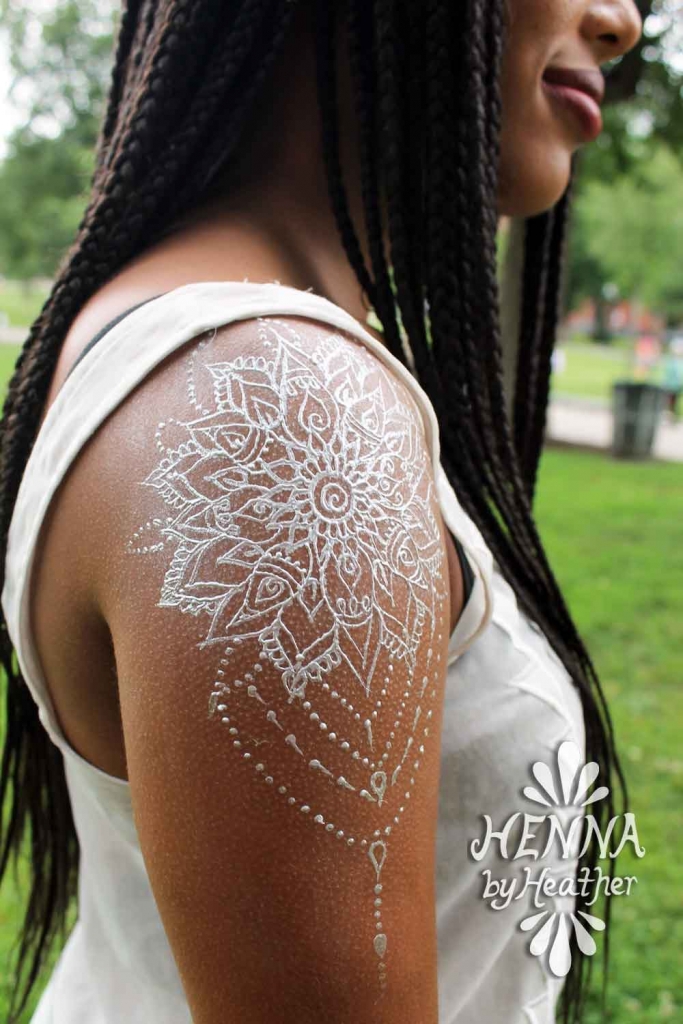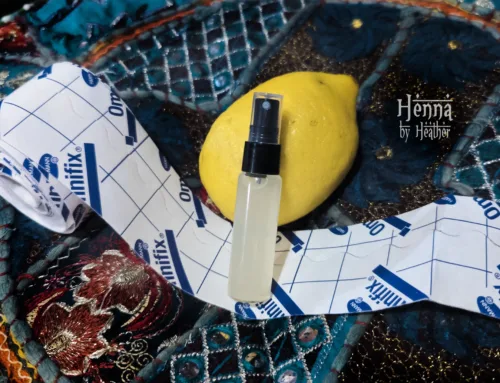Dear Heather,
I’ve seen lots of images of white henna on the interwebs lately, especially on Instagram, Pinterest, and the like. It’s so pretty. Can you hook me up?
Sincerely,
Trendy Henna Lover
If you just came to find a source of white henna – skip on ahead.
Dear Trendy,
Thanks for coming to me with your body art questions!
As you are a bit of a contrived summary of every question I’ve ever gotten about “white henna” lately, I’m going to give you a really nice and long answer, that answers EVERY possible question you or any of your real human counterparts could have about it, hopefully.
First off, I’d like to be clear that what people have been calling “white henna” is actually not henna at all.
Henna artists are especially sensitive to non-henna stuff being called “henna”, since in the past, some really harmful stuff has been inaccurately called “henna” and caused some real damage. In particular, “black henna” is particular dangerous, and is made with a toxic chemical called PPD that is never intended to be used on skin and can cause chemical burns and internal organ damage.
Real, true henna, that we can validly call henna without putting “airquotes” around it, is the henna plant, lawsonia inermis. While the henna plant goes by many names in many languages (mehndi, kopher, camphire, mehandi, mehendi, heena, etc), the word (in whatever language you’re using) really only refers to things done with this natural dye, made from the leaves of the henna plant.
True, natural henna lasts 1-3 weeks because it dyes the top few layers of your skin. “White henna” only lasts a few days, because they just sit on top of the surface of the skin, rather than dying it.
So, what is this “white henna” stuff, if it’s not henna?
Well, it varies. The very best of it is a combination of ProsAide cream adhesive (or similar skin-safe cosmetic or medical adhesive) and white mica (or other skin-safe pigment). Henna artists have been using this stuff for YEARS, perhaps a decade or more, actually, to satisfy the desire to do pretty art on the skin in a color other than the beautiful, natural, reddish-brown of henna. It’s got a luxurious shimmer to it, and is totally skin safe. Artistic Adornment sells kits for doing it. Other places do, too.
That’s the most popular method – apply ProsAide adhesive, let it dry until it’s clear and tacky, and then dust white mica over the top. It lasts 2-7 days, depending on how you care for it.
You can also use white body paint or any other number of FDA-approved, skin-safe cosmetics. If it’s white, and is safe for use on skin, go for it! Draw henna styled designs in white on your skin using it! Just don’t call it henna and we’re cool.? Call it “white henna” and be sure to put it in quotation marks to drive home the point that it is not actually henna, or call it whatever it actually is – White mica with ProsAide, white body paint, white eyeliner, etc, etc.
You sure are harping on it being skin-safe. What wouldn’t be skin-safe that I might’ve seen as “white henna”?
You wouldn’t believe?what sort of craziness humans will do in the name of beauty. Or maybe you would. I’ve personally heard reports of people trying to?bleach the skin to get that “white henna” look. I’ve also heard of people drawing on themselves in puffy paint intended to be used on fabric. You are not a tshirt; you deserve better than puffy paint. Who knows what that is doing to your skin??
There are so many white-colored things to put on your skin that are safe. The best to use for a henna-style application, that can be applied with a cone and everything, for the same nice, smooth lines, would be the ProsAide adhesive with white mica mentioned before.
Are there any reasons I wouldn’t want to give this ProsAide and Mica Pretenna stuff a try?
Why yes, actually. Even though it?is skin-safe, any of these cosmetics that are applied to the surface of the skin are actually not okay if you’re a really devout Muslim who wants to do wudu for prayer. ProsAide creates a barrier between the skin and water; it is water impermeable. So, for the same reasons you can’t wear regular nail polish, you can’t do “white henna” either.
The reason that actual, real, natural plant-based henna is okay for wudu is that henna stains the skin cells, but does not create any sort of barrier between water and the skin. So technically, it’s totally cool to wear henna and also perform wudu for salah / prayer.
But really, can you please do some White Pretenna for me?
Sure! Now that you understand that it’s not henna, and that it won’t last as long as henna, etc, etc, I will be happy to do some white pretenna for you at a private event. The rate for all my services is the same, regardless of medium. Real henna is a little faster to do, since it is a one-step process, whereas “white henna” is a two-step process. Also, since it sits on the surface of the skin rather than actually dying the skin the way henna does, it does not last as long. Also, it’s not all-natural the way henna is. If you’re fine with all these things, I am happy to do it for you.
And you don’t have to just do white! You can do literally any color of the rainbow. I can match your bridesmaids’ dresses, your prom dress, etc.
Happy Hennaing,
Heather
———————–
The “Dear Heather” column is inspired by Dear Abby and Heather’s fellow henna artists’ and clients’ most frequent and/or unique and interesting questions.
Henna artists who read the “Dear Heather” column are reminded that Heather also sells henna supplies at ArtisticAdornment.com, and your support helps keep Heather happy, helpful, and henna-focused!
Do you have a henna related question for Heather? Send it today with subject “Dear Heather” to info@hennabyheather.com.
Want to learn the ins and outs of running a henna business, and be sure that Heather is available to you personally to answer your henna questions? Join Heather’s “Business of Henna” email list below to be notified when the next session of her signature Business of Henna class will run.





